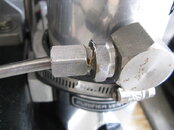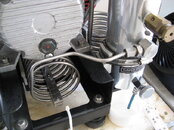realdiver7
Contributor
I need help figuring out how to install a check valve at the bottom input of the filtration canister on an Alkin W31 electric compressor with manual drains. If I remove the round 1/4 in. fitting and install the approx. 3 in. long (female to male airflow) check valve coming straight off of the canister, the valve sticks out so far I can't cover the compressor with the wooden cover, or more importantly, safely route the coiled tubing from the 3rd stage without overbending it. What kind of elbow fittings, creative routing, etc. do you use to make the check valve fit?
By the way, I'm installing the check valve in order to keep the filtration canister pressurized when the compressor is not being used so I can hopefully prolong filter media life.
Edited to add: I already have a backpressure regulator (priority valve) installed at the outlet on the top of the filter canister.
See pictures below of how the round 1/4 in. fitting goes straight into the filtration canister.
Thanks!
By the way, I'm installing the check valve in order to keep the filtration canister pressurized when the compressor is not being used so I can hopefully prolong filter media life.
Edited to add: I already have a backpressure regulator (priority valve) installed at the outlet on the top of the filter canister.
See pictures below of how the round 1/4 in. fitting goes straight into the filtration canister.
Thanks!
Attachments
Last edited:






